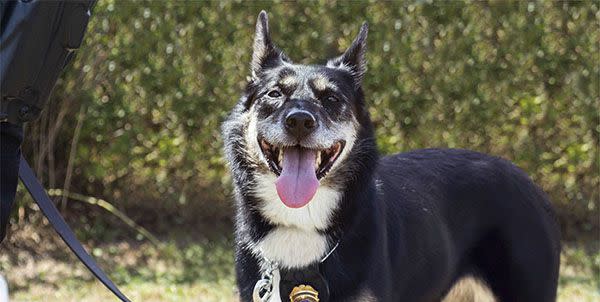This Abandoned Shelter Dog Rescued the Missing Son of Her Former Trainer

Once an unruly stray, Ruby became a hero to the volunteer who tirelessly trained her.
Before Ruby, a 7-year-old Australian shepherd-Border collie mix, joined the Rhode Island State Police (RISP) in 2011, she had been adopted and returned to the Rhode Island Society for the Prevention of Cruelty to Animals shelter in East Providence five times in a year.
But shelter volunteer Patricia Inman refused to give up on her, tirelessly working on Ruby's manners each time she was returned in hopes of making her easier to adopt. "She wasn't aggressive," says Patricia. "She just had a big personality."

Patricia's efforts paid off in August 2011, when now-retired RISP sergeant Matthew Zarrella visited the shelter and noticed Ruby's exuberance and eagerness to please - perfect qualifications for the department's search and rescue team. The police department paired her with trooper Daniel O'Neil, and by 2017, Ruby had helped with more than 15 missing-person cases.
In October 2017, Daniel and Ruby responded to a call that hit close to home. Patricia's son had gone missing. Rescuers had looked for the teen for more than a day with no luck. But after several hours of searching, Ruby picked up a scent and ran straight to the boy, who was unconscious but alive in the woods near Patricia’s house.
Daniel broke down in tears when he shared the good news with Patricia. "Because of you, Ruby got a second chance at life," Daniel told her. "And now she saved your son’s."
Training Time: How to Get Your Dog's Attention
If your pooch is in trouble - say, wandering toward a busy road - a recall command will make him stop in his tracks and run back to you. Here's how to teach it:
1. Choose an uncommon word.
Some trainers use the "come" command in different languages; others use totally random words like "gopher" or "stopwatch." Whatever you choose, rely on it only in a true emergency.
2. Practice, practice, practice.
Drill the word in various scenarios and settings - in the house, in the yard, at the park - with and without distractions, such as other dogs and loud noises.
3. Have fun.
Mills suggests turning your drills into a game. Try the ping-pong method: Station one person in a bedroom and another in the kitchen. Take turns saying the word to test how well your dog responds.
4. Ramp up rewards.
Give your dog a special treat to praise him for obeying the emergency recall command, so that he begins to realize its importance.
5. Don’t use it every day.
Keep your pet sharp by practicing the command a few times a week, but don’t overuse it. And never associate your recall word with an unpleasant activity for your dog, like nail trimming or bathing.
Safety First: How to Pack a Dog Evacuation Bag
In case of emergency, keep a pet "evac-pack" at the ready. According to Dick Green, senior director of disaster response for the ASPCA field investigations and response team, your kit should include:
Copies of your pet's medical records and a waterproof container with a two-week supply of any medicine he takes.
Recent photos of your pet.
A bag, crate, or sturdy carrier labeled with your pet's name and your contact info.
Three to seven days' worth of canned (pop-top) or dry food, and several gallons of water.
This story originally appeared in the November 2018 issue of Woman’s Day.
('You Might Also Like',)


